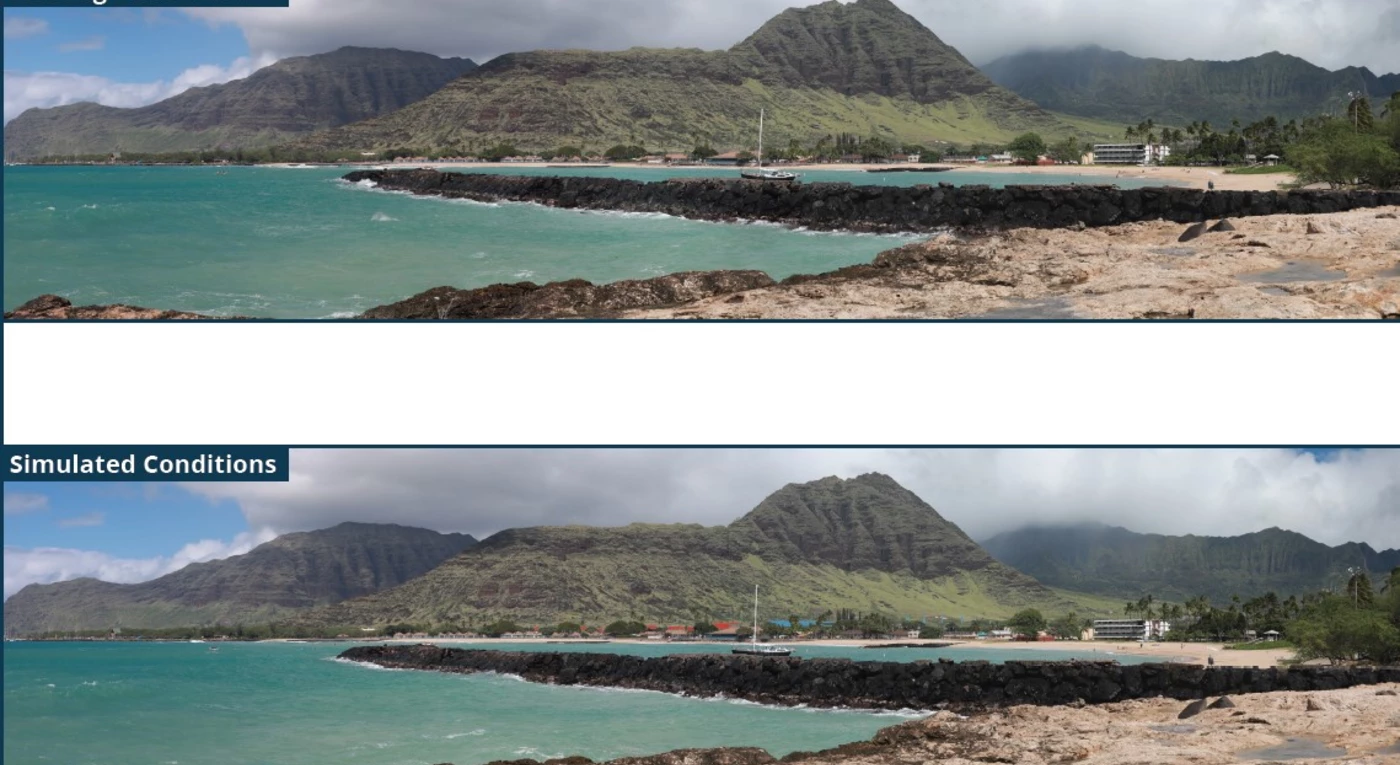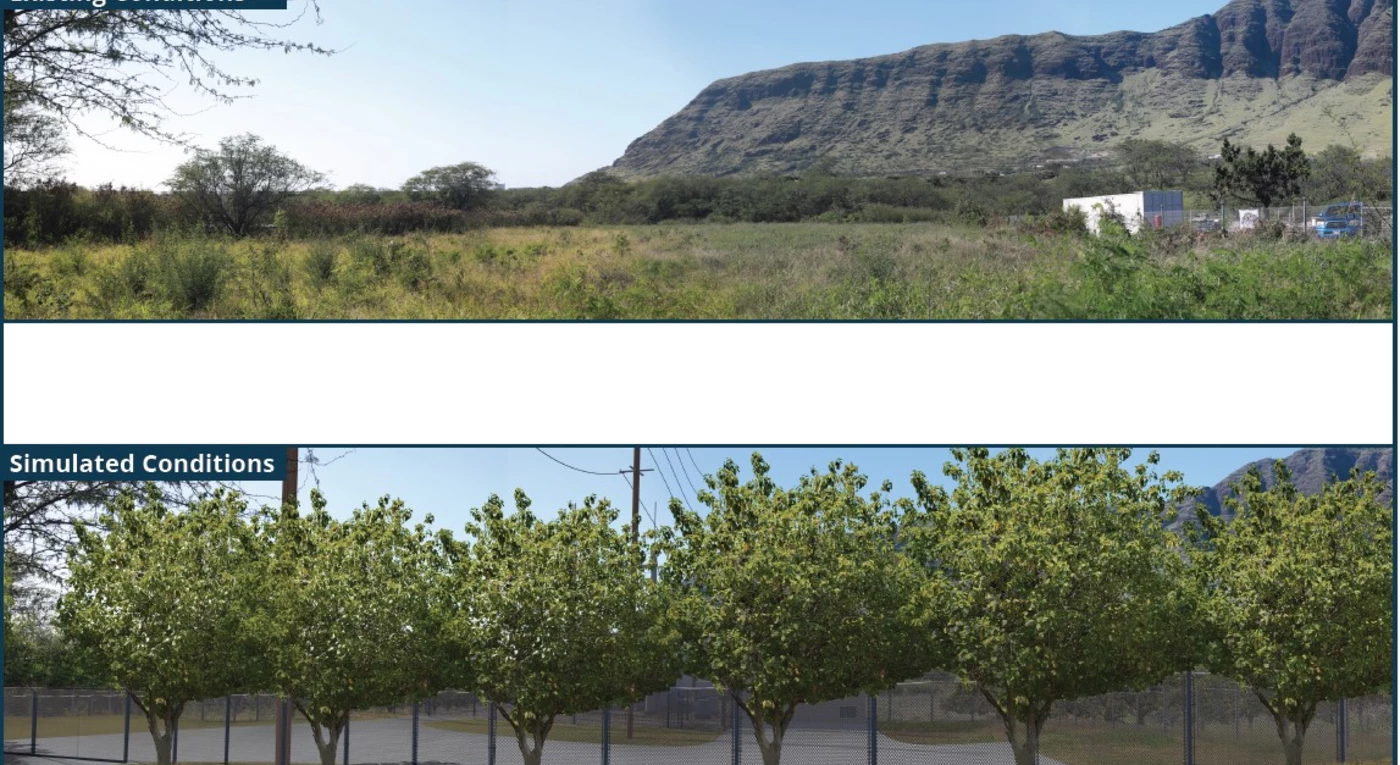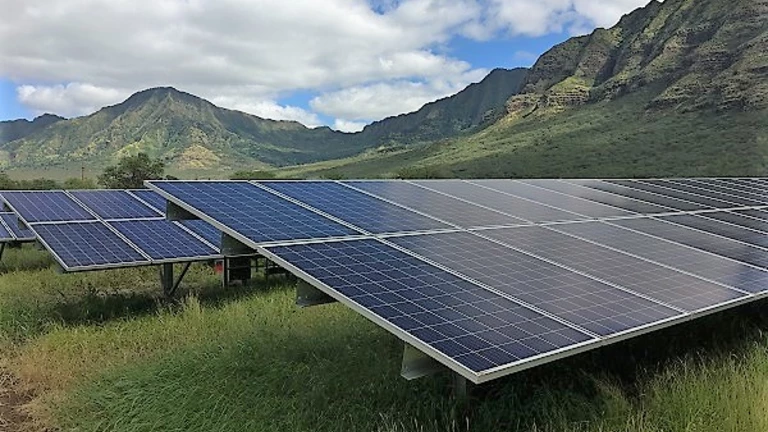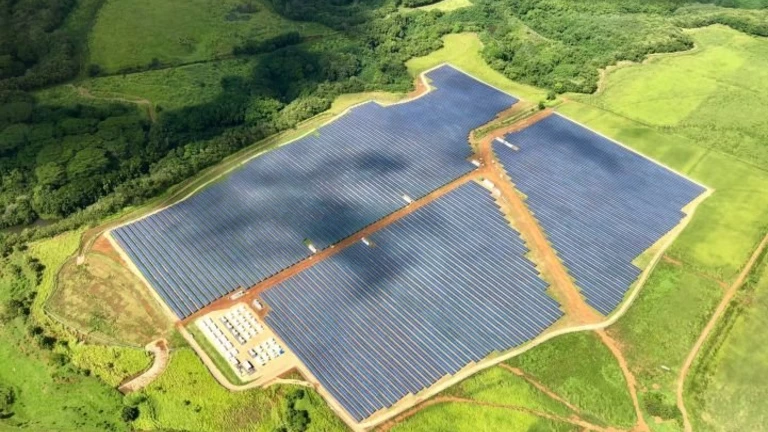Community outreach
Project contact information
If you have any questions or concerns please reach out to our Community Outreach Representative.
Community Outreach Representative: Carrice Gardner
Email: aesmountainviewsolar@aes.com
Project Hotline: +1 (808) 800-3942
Regulatory approvals and community outreach
August 9, 2022, Presentation to Waianae Neighborhood Board Housing & Homelessness Committee
Minutes
April 2022, City and County of Honolulu Conditional Use Permit, minor (CUP-m) & Zoning Waiver Request
March 16, 2022 — 5th Public Community Meeting
December 16, 2021 — 4th Public Community Meeting
September 29, 2021 — 3rd Public Community Meeting
May 19, 2021 — 2nd Public Community Meeting
April 27, 2021 — Presentation to Waianae Valley Homestead Association
July 14, 2020 — Early-Stage Public Community Meeting
Public Utilities Commission DOCKET no. 2020-0139
Community Outreach Plan
Visual simulations
After hearing from the community, our project team returned to the drawing board and completely redesigned the project to incorporate community feedback. The new design doubles the distance between the project and the nearest residential houses, decreases the project's visual impacts, and reduces the amount of grading by 55% (approximately 150,800 cubic yards of grading, fill, & dust avoided). The visual simulations below represent the project redesign and are different from the first set of visual simulations shown to the community.



As an initial step in the strategic community outreach process, the AES project team conducted a virtual public meeting to capture comments and feedback from the community. The meeting was held on July 14, 2020. A recording of the meeting can be found here.
A second virtual public meeting was held on May 19, 2021. A recording of the second meeting can be found here.
We have received valuable feedback from community members and interested stakeholders during early-stage outreach. Comments, questions, and feedback have directly contributed to the studies being conducted and project design. AES is in the process of evaluating the priority issues identified by the community and is committed to proactively addressing these as part of the Project's ongoing design efforts.
A third virtual public meeting was held on Sept. 29, 2021. A recording of the third meeting can be found here.
A fourth virtual public meeting was held on Dec. 16, 2021. A recording of the fourth meeting can be found here.
A fifth virtual public meeting was held on March 16, 2022. A recording of the fifth meeting can be found here.
View the presentationCultural surveys
AES is deeply committed to responsibly developing its Projects. In keeping with this principle, we have prioritized efforts to study the cultural, archeological, and historic features of the proposed project site.
AES is working with Honua Consulting, to update a previously-accepted Archaeological Inventory Survey (AIS) in consultation with the State Historic Preservation Division (SHPD). Archeological fieldwork was completed in January 2021 with draft report expected in Q2 2021.
In addition, AES has engaged Honua Consulting to conduct a Cultural Impact Assessment (CIA) for the Project. We encourage interested parties, especially native Hawaiians and those with cultural or historic knowledge of the region to participate in the CIA by contacting Honua Consulting at community@honuaconsulting.com or (808) 392-1617.
Preliminary site assessment
AES and its environmental consultant conducted a preliminary assessment of the environmental conditions at the site based on a review of publicly available maps, studies, and previous environmental reports prepared for the property. More detailed information is being obtained through due diligence and site-specific studies, as well community feedback, and will be used to inform the design process.
The Project design will seek to avoid and minimize environmental impacts to the extent possible. Best Management Practices (BMPs) will be implemented to further minimize impacts throughout the Project lifecycle.
Feedback will be collected throughout the Project lifecycle, and updates will be provided as outlined in the Community Outreach section above. To get the latest project information sign up for our newsletter.
Air quality
None of the equipment associated with the solar arrays or battery storage system emit air pollutants of any kind. Overall, the Project would provide a net benefit by replacing energy generated by burning fossil fuels with renewable energy, thereby reducing emissions of greenhouse gases.
Natural Habitats and Ecosystems, Vegetation, and Wildlife
A biological survey was conducted to characterize the existing plant and animal habitat and determine whether species that are federally or state listed as threatened or endangered (pursuant to the federal Endangered Species Act or Hawaiʻi Revised Statutes [HRS] 195D), or are otherwise considered rare, have the potential to occur and could be impacted by construction or operation of the Project.
The results of the survey indicate that the Project area has been extensively modified by previous agricultural operations and is dominated by non-native species. Vegetation types in the Project area include kiawe/buffelgrass forest, koa haole scrub, non-native grassland, ruderal vegetation and cultivated fields. No federally or state listed plant or animal species were documented within the Project area, although several could possibly occur within or traverse over the Project area.
The Project is being designed to minimize ground disturbance and maintain ample, natural open space surrounding the Project facilities. Impacts to natural resources, including listed species that could possibly occur within or traverse over the Project area, would be avoided and minimized to the extent possible through implementation of standard measures.
Climate
The Project would generate clean renewable energy which would replace the burning of fossil fuel for the production of electricity, thus offsetting greenhouse gas emissions and providing a beneficial impact on climate conditions. Hawaiian Electric has determined that the Project would displace approximately 872,886 barrels of fuel, and would decrease greenhouse gas emissions by approximately 379,040 metric tons over its lifetime.
Flood and tsunami hazards
The project is not within the FEMA 100-year flood plain or the tsunami evacuation zone.
Noise
Once operational, the Project is anticipated to generate minimal noise.
Roadways and Traffic
Early-stage community feedback indicated a desire to minimize damage to roads and impact to local traffic. For that reason, a traffic impact analysis report (TIAR) was conducted to evaluate the traffic impacts resulting from the proposed AES Mountain View Solar Project. It is AESʻ goal to minimize traffic impacts to the surrounding community. The analysis concluded that the Project during construction and through operation will have no significant impact on the surrounding facilities.
During construction, it has been suggested by the traffic engineer that AES utilize the access route Farrington Highway to Plantation Road for ingress and egress of construction vehicles, including WB-67 designed vehicles. Construction workers may utilize this route as well as the Farrington Highway to Waianae Valley Road route to get to and from the Project Site. It is AES’ intent to maintain roads and repair any damage that may be caused as a result of construction activities. Any mitigation identified in the TIAR will be implemented during construction of the Project.
Visual Resources
A visual impact analysis which identifies a zone of visual influence has been conducted, and visual simulations are being developed to assist with refinement of the location of Project components in order to minimize the impact to neighboring residents and on the rural character of the area to the extent practicable. As AES progresses with the Project’s design & engineering efforts, visual simulations will be updated to reflect refinements to the Project design.
Solid waste
The facility is not anticipated to generate solid waste. The Project will be decommissioned at the end of its lifecycle and the Project area will be returned to its existing condition (or comparable). A decommissioning plan will be developed to ensure Project components are recycled in accordance with standards and regulations applicable at the time of decommissioning.
Water features
A delineation was conducted within the Project area to identify any water features, such as wetlands or streams, that may be considered Waters of the U.S. and therefore subject to regulation by the U.S. Army Corps of Engineers (USACE) under Section 404 of the Clean Water Act.
Fieldwork for wetland delineation was completed in February 2021, and the delineation report will be compiled and submitted to the USACE for their jurisdictional determination. The Project will be designed to avoid any jurisdictional Waters of the U.S. to the extent possible.
Topography and Geotechnical
Topographic and geotechnical surveys have been conducted to inform Project design as well as to minimize site disturbance and the overall Project footprint through the optimization of the placement of Project components.
Storm water Runoff and Water Quality
The Project is not anticipated to have an impact on water quality. The Project is being designed to avoid onsite water features and Best Management Practices (BMPs) will be implemented to minimize runoff or other potential water quality impacts.
As noted above, the topographic and geotechnical survey is being used to inform the civil and storm water management design. As the Project would incorporate low impact design techniques and would involve a relatively minimal increase in impervious surfaces (with subsequent removal as part of Project decommissioning), it is not expected to substantially affect storm water discharge. All storm water will be contained within the Project area. In addition, BMPs will be implemented to minimize the potential for sedimentation and erosion, such that the Project is not anticipated to have an impact on water quality.
Land Use Agreements and Title
The Project will be developed within the area identified in the land agreement with the landowner, utilizing the least amount of land reasonably possible.
Supporting compatible agricultural activities
AES is working closely with the landowner, who operates an active farming business adjacent to the Project area, to utilize the least-productive agricultural areas in order to generate additional income for the landowner to support his ongoing farming operations. Additionally, AES has engaged an agricultural consultant and intends to work with agricultural specialists, the landowner and community members who are interested in engaging in agricultural activities to identify potential compatible agricultural partnerships.
Permits
State Land Use and County Zoning Classification
The Project area is located within the State of Hawai‘i agricultural land use district and the City & County of Honolulu General Agricultural (AG-2) zoning district. The Project will be designed to occur on land not currently being farmed by the landowner, in areas with the least productive soils (Class E & C) as classified by the Land Study Bureau (LSB) such that a state special use permit is not expected to be required.
The proposed solar facility is consistent with these state and county land use regulations. No changes in the land use classification or zoning district would be required for Project implementation.
Discretionary and non-discretionary land use, environmental and construction permits and approvals
Based on a preliminary review, the following determinations have been made:
U.S. Federal
- Federal permits or approvals are not anticipated for project implementation
- Compliance with the National Environmental Policy Act (NEPA) is not anticipated
City and County of Honolulu
- Conditional Use Permit (minor)
- Zoning Waiver may be required
- Additional building permits are anticipated, including:
- Electrical permits
- Grading/grubbing/stockpiling permits
State of Hawai‘i
- An Environmental Assessment (EA) or Environmental Impact Statement (EIS) are not anticipated – the project does not “trigger” HRS Chapter 343.
- Certain construction-related State permits may be required, including:
- a National Pollutant Discharge Elimination System (NPDES) permit
- a Noise Permit
- Compliance and coordination with the State Historic Preservation Division under HRS Chapter 6E is anticipated
Anticipated permits and approvals
|
Permit Name |
Authority Having Jurisdiction |
|---|---|
|
HRS Chapter 6E Compliance (Historic Preservation Review) |
SHPD |
|
National Pollutant Discharge Elimination System (NPDES) |
DOH - Clean Water Branch |
|
Noise Permit |
State Department of Health (DOH) - Indoor and Radiological Health Branch |
|
DPP |
|
|
Building Permit & Electrical |
DPP |
|
Grading & Grubbing & Stockpiling Permit |
DPP |
Contact us
We appreciate your interest and participation in Hawaiʻi's renewable energy future. We look forward to hearing your ideas, thoughts and comments.
Community Outreach Representative: Carrice Gardner
Project Hotline: +1 (808) 800-3942
Email: aesmountainviewsolar@aes.com
If you are interested in receiving updates about Mountain View Solar + Storage project, please fill out and submit this form.






